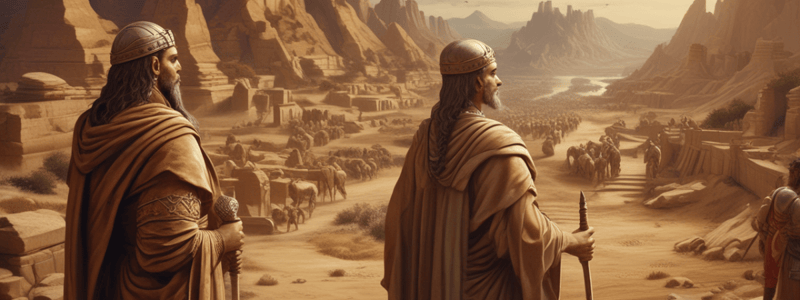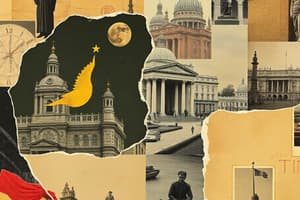Podcast
Questions and Answers
Quelle période historique a été marquée par un intérêt renouvelé pour l'art, la littérature et la philosophie de la Grèce et de Rome?
Quelle période historique a été marquée par un intérêt renouvelé pour l'art, la littérature et la philosophie de la Grèce et de Rome?
- Période moderne précoce (correct)
- Période moderne tardive
- Période moderne
- Période contemporaine
Quel événement marqua la période moderne précoce allant du 16ème au 18ème siècle?
Quel événement marqua la période moderne précoce allant du 16ème au 18ème siècle?
- La Réforme protestante
- La Révolution scientifique (correct)
- Les Croisades
- La Renaissance italienne
Qu'est-ce qu'une source primaire en histoire?
Qu'est-ce qu'une source primaire en histoire?
- Un compte-rendu de première main (correct)
- Une source provenant de l'internet
- Un compte-rendu de seconde main
- Une interprétation d'une source primaire
Flashcards are hidden until you start studying
Study Notes
History
Prehistory and Early Civilizations
Prehistory refers to the time before written records and includes the Stone Age, Bronze Age, and Iron Age. The Neanderthals, a group of early humans, lived in Europe and Asia between 400,000 and 40,000 years ago. The first civilizations emerged in Mesopotamia (present-day Iraq) around 3500 BCE, followed by ancient Egypt around 3100 BCE, the Indus Valley Civilization in India around 2600 BCE, and China's Shang Dynasty around 1600 BCE.
Classical Civilizations
Classical civilizations developed in Greece and Rome, with Greek city-states leading the way from around 800 BCE. The Romans, starting as a small Latin settlement, grew into a powerful empire that lasted from 753 BCE to 476 CE. These civilizations made significant contributions to art, philosophy, and politics, and their influence can still be seen today.
Middle Ages
The Middle Ages, also known as the Medieval period, lasted from the 5th to the 15th centuries CE. It was a time of political fragmentation, with feudalism and the rise of monarchies. The period saw the spread of Christianity and the establishment of the Roman Catholic Church, which played a significant role in European society.
Renaissance
The Renaissance, which began in Italy in the 14th century, marked a period of cultural and intellectual rebirth. It was characterized by a renewed interest in classical Greek and Roman art, literature, and philosophy, as well as significant advancements in science and exploration.
Early Modern Period
The early modern period, from the 16th to the 18th centuries, was marked by the rise of nation-states, the spread of colonialism, and the Scientific Revolution. This period saw significant advances in science, technology, and commerce, as well as the emergence of modern European culture.
Modern Period
The modern period, from the 18th century to the present, has been marked by the growth of industrial society, the rise of democracy, and the expansion of global connections. It has also seen significant political upheaval, including two world wars and the Cold War.
Europe's Diversity and Unity
Europe's diverse peoples and cultures have played a significant role in shaping its history. The idea of European unity dates back to the Roman Empire and was imperfectly embodied in Charlemagne's empire and the Holy Roman Empire. European unity was further proposed by Jean Monnet and other statesmen in the aftermath of World War II, leading to the establishment of the European Union.
Primary and Secondary Sources
Primary sources are first-hand accounts or records created during the time under study, while secondary sources are second-hand accounts or interpretations of primary sources. Both primary and secondary sources are essential for historical research, with primary sources providing firsthand information and secondary sources offering context and analysis.
Studying That Suits You
Use AI to generate personalized quizzes and flashcards to suit your learning preferences.




